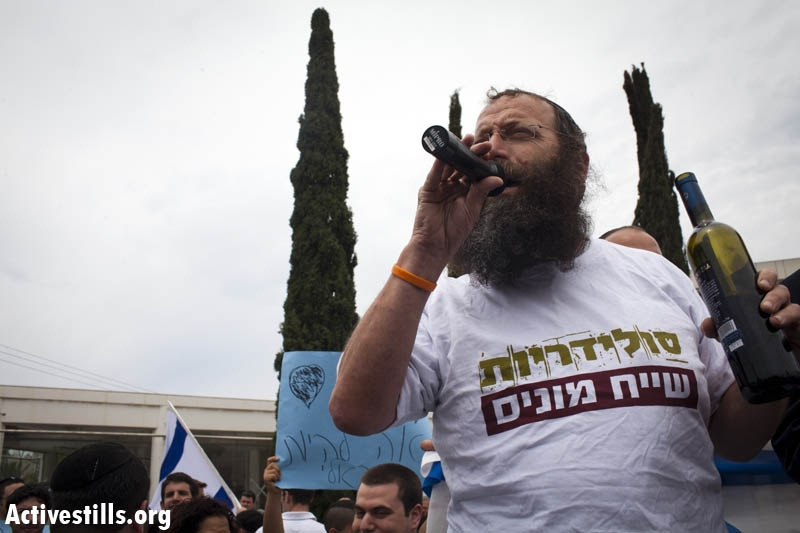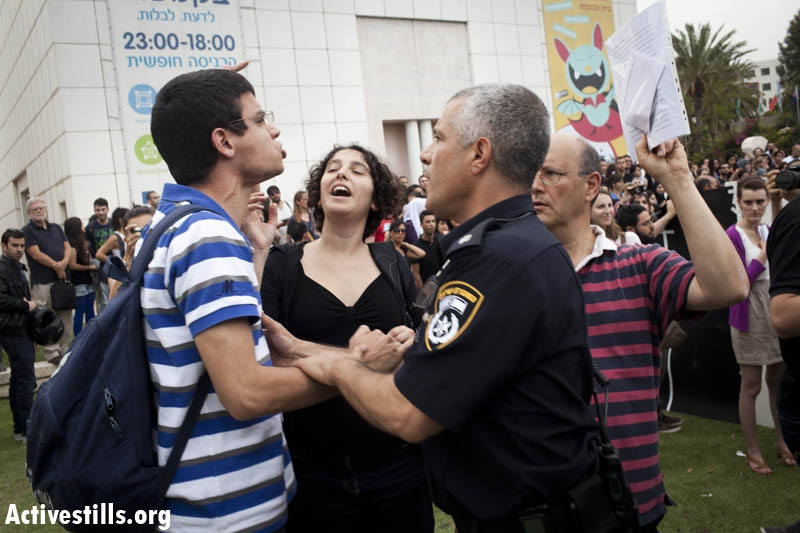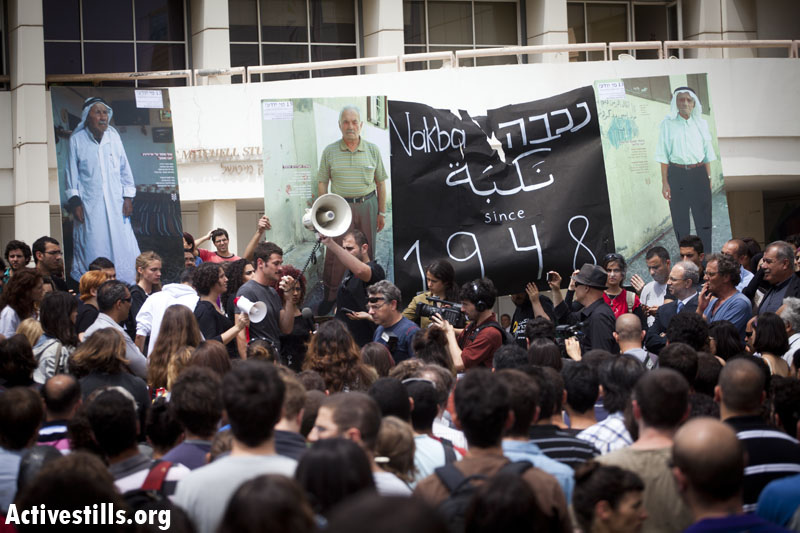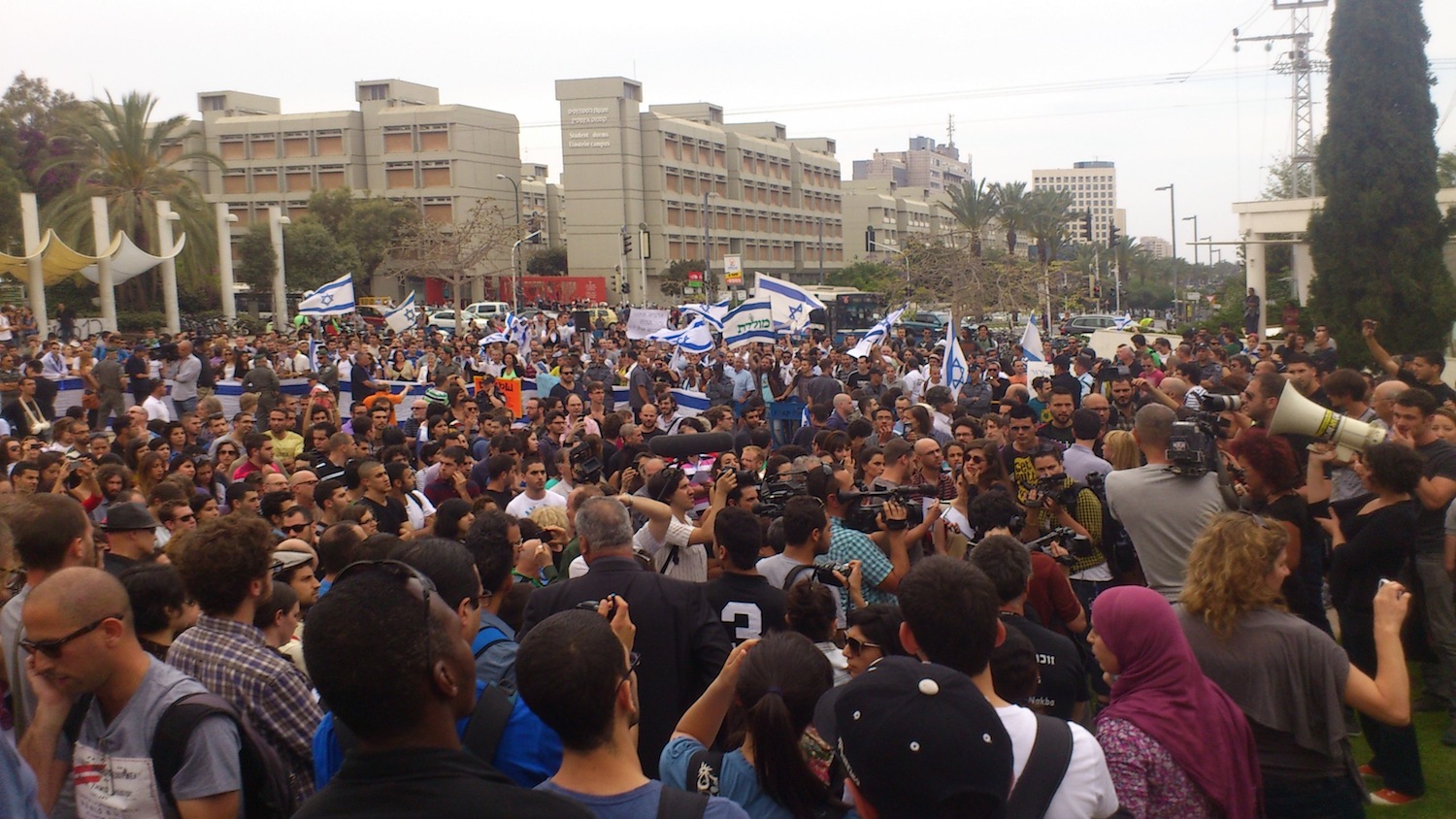A ceremony commemorating the Nakba was held at Tel Aviv University on 14.5.12. This was the first time a ceremonial commemoration of the Nakba was held on Nakba Day at central public site, on an Israeli university campus, with the participation of so many Israelis and Arabs.
The event attracted considerable media attention – television, radio and newspapers. It was organized by the university’s Hadash student group, led by Noa Levy. Zochrot provided assistance, support and inspiration.
One of the ceremony’s high points was when Sa’ar Szekeli read a memorial text:
In memorium
We, Jews and Arabs, have gathered here today to commemorate the Palestinian catastrophe, the Nakba.
Those who were killed, those who were expelled from their villages, those who fled for their lives, who were not allowed to return home, who became refugees in their own land and in foreign refugee camps.
Today we commemorate 64 years of pain and of silencing, of clinging to the land and being ripped from it, the loss of human dignity, trampling of the rights of those who are present and those who are absent.
530 Palestinian villages were uprooted. Some of their inhabitants were expelled. Some were killed. Some fled from the terror of death and weren’t permitted to return. 95% of the Arab population, more than 750,000 people, became refugees.
The movie theaters were orphaned. The Arab printing houses were destroyed. The theaters and clubs emptied. Those who told tales in cafes fell silent. The political and cultural landscape of the Middle East was torn apart, split. Arabic became a foreign language in its own country.
That is the catastrophe which created the state of war we live in. That is the disaster we were forbidden to acknowledge, whose implications we haven’t yet confronted. It led to military government, land expropriations, discrimination, dispossession and political repression, to a regime in which some are more equal than others, of first-class and second-class citizens.
And, in addition to all this, the refugee camps also filled. We refuse to forget the refugees.
We have an obligation as human beings to remember, not to forget.
Although our stories may differ, life and freedom are sacred to us all.
May the Jewish people remember. May the Palestinian people remember. May we all remember.
Palestinian students recounted the events of the Nakba in their villages:
My name is Rasul Sa’adeh, originally from the village of Mi’ar. In June, 1948, the village was attacked by an armed force during the fighting in the western Galilee. Tanks entered the village and it was declared a military area. Some of the inhabitants fled to Lebanon and some found refuge in nearby villages. After three months the villagers returned, believing that after the fighting had ended they’d be able to live there quietly. In October, the army reentered the village, loaded the inhabitants onto trucks and took them to Syria and to Lebanon. At the beginning of 1949, more inhabitants of Mi’ar, who today are living in the surrounding villages, returned to their homes and were expelled for the third time, to villages in the area. This time the army demolished the village buildings. Only 25 years later, in 1973, was my family able to find a permanent place to live, in Shefa ‘Amr, half an hour drive from Mi’ar. A few years ago the Misgav Regional Council decided to demolish the village cemetery and build on the site a residential neighborhood for Ya’ad, a nearby Jewish moshav that had been established where the village stood. Mi’ar’s uprooted inhabitants met with the residents of Ya’ad and, after they explained their objections to the construction of a new residential neighborhood on their ancestors’ graves, the residents of Ya’ad and Mi’ar jointly approached the regional council and requested that the planned neighborhood be relocated beyond the cemetery’s boundaries. Mi’ar’s story demonstrates that it’s possible to recognize the injustice and seek ways to redress it through mutual respect and cooperation between the two peoples.
My name is Rula Hal’ayleh, from the village of Majd al-Krum. My family was expelled from the village in 1949. The Haganah came, collected all the inhabitants in the center of the village. Two were killed without provocation, in order to frighten the others. They bound the men’s hands and put them, with the women and youths, in the backs of army trucks. They unloaded my grandparents, on both my mother’s side and my father’s side, in the town of Zara’a, in Jordan. None of my grandparents accepted their expulsion and began a three-year journey to Lebanon, and in 1952 finally succeeded in “infiltrating” back to their homes. That’s why I live here today, and not in a refugee camp.
My name is Ruba Salam, from the village of Ma’alul, next to Migdal Ha’emek. The village still stands empty today. An army base was established next to it, which is why we can’t move freely there. On 15.7.1948, the village learned that the residents of Jaffa had been expelled. That same evening a villager was shot in the head at home and killed. The soldiers on the opposite hill began firing at everyone who went outside. The mukhtar decided that all the villagers would leave for two weeks and return when the fighting died down. We were never permitted to return. The families were uprooted and are scattered today in Yafia, Nazareth, the United States, Jordan. My grandfather still has the key to his old home.
My name is Jihad Qi’al. My family is from the village of Birwa, in the Galilee. During the war the Chrisitian priest told my family not to leave the village, but the residents departed on orders from the Arab Liberation Army which promised they’d be able to return in a week. A week later the village priest gathered the people, told them the army wouldn’t allow them to return and convinced them to go back to their homes. They returned to the village but were expelled again a week later. This time the Israeli army entered the village and murdered everyone who had a weapon. Three villagers were murdered. After the Arab army withdrew, only fighters from the village and from neighboring villages remained. They had no defense against the Israeli army and left for the neighboring villages. After two months in Majd al-Krum they went to Judeide, where we still live today. Every year, on the anniversary of the nakba, we drive to Birwe to remember our origins. The village school and other public buildings were destroyed. They also wanted to destroy the cemetery and erect a cowshed instead. Three years ago we successfully sued in the High Court of Justice to stop the demolition. Only the cemetery remains. Moshav Ahihud and Kibbutz Yas’ur now sit on our lands.
My name is Rena Raslan, from the village of ‘Iblin. Fellahin from the village would cultivate their lands every day, while the women and children remained at home. One day soldiers came to the village to expel the fellahin. They fired into the air; my grandfather’s family fled together with most of the other families in the village. My grandmother was pregnant, in her seventh month, which is why she and my grandfather were among the only people who stayed. All the rest of my family lives today in a refugee camp in Lebanon. When the other residents of the village fled, my grandfather and grandmother hid along with the other few who’d remained in an underground ditch. When my grandfather and grandmother emerged from hiding they found their home destroyed, they were declared absentees and their land was expropriated. In order to build a new home they were forced to repurchase their own land from the state. All my family’s lands were expropriated, lands which were their main source of income.
My name is Roslyn Husri, from Hawsha, a village in the Galilee, between Shafa ‘Amr and ‘Iblin. The villagers heard a rumor about what was happening in the area, in the nearby villages and towns. There were rumors that inhabitants were being killed and expelled. So the people got up, left the village and scattered among the nearby towns and villages. My immediate family reached Umm el-Fahm. My grandparents moved in with their relatives and remained there. The members of my extended family scattered to the four corners of the earth; some of my relatives became internal refugees and others became external refugees. We internal refugees lost our homes, our lands, members of our families. Today our relatives live in the Yarmoukh refugee camp in Syria. A Jewish moshav was established on the lands of our village.
My name is Jabbar Bassal. Today I live in Judeide al-Makr. My family was uprooted in 1948 from the nearby villages of Birwe and Damun in the western Galilee. In April, 1948, the Israeli army captured Birwe and expelled its inhabitants, leaving many dead behind. The residents of Damun didn’t wait for their turn; they joined the inhabitants of Birwe and the other nearby villages. The army caught those who fled, loaded them onto trucks and took them to Lebanon. Some managed to escape and settle in Julis and in Judeide. The members of my family who had been dumped in Lebanon managed to “infiltrate” back in 1951 and join their relatives in Judeide. 90% of the population of Judeide are expellees; the village became a kind of refugee camp within Israel. Today it’s still the Israeli locality with the highest level of unemployment.
Eitan Bornstein, from Zochrot, read part of Majduline Bidas’ testimony. She’s a refugee from the village of Shaykh Muwannis. Tel Aviv University was built on it’s ruins. Today it still refuses to erect on its grounds a sign that refers to the village.
Participants observed a minute of silence in memory of the Nakba.
This was one of the most important events in the history of the struggle to remember the nakba, and against its denial by Israel.

טקס לנכבה באונ' ת"א / Nakba ceremony TLV University

טקס לנכבה באונ' ת"א / Nakba ceremony TLV University

טקס לנכבה באונ' ת"א / Nakba ceremony TLV University



